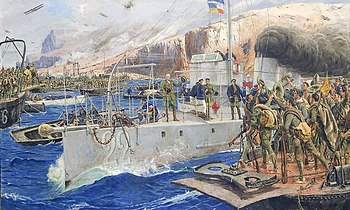War of Melilla
| Rif War | |||||||
|---|---|---|---|---|---|---|---|
| Part of Interwar period and Berber separatism in North Africa | |||||||
 Alhucemas landing by José Moreno Carbonero |
|||||||
|
|||||||
| Belligerents | |||||||
|
Jebala tribes |
Jebala tribes |
||||||
| Commanders and leaders | |||||||
|
Mulai Ahmed er Raisuni (POW) |
|
||||||
| Strength | |||||||
|
Total: 465,000 soldiers +200 aircraft |
Spanish estimate: 80,000 irregulars(Never more than 20,000 with firearms) including less than 7,000 "elites" Other sources: autumn 1925: 35,000–50,000 March 1926: less than 20,000 |
||||||
| Casualties and losses | |||||||
|
8,500 wounded |
30,000 casualties (of which 10,000 dead) | ||||||
The Rif War was an armed conflict fought during the first half of the 1920s between the colonial power Spain (later joined by France) and the Berber tribes of the Rif mountainous region. Led by Abd el-Krim, the Riffians at first inflicted several defeats on the Spanish forces by using guerrilla tactics and captured European weapons. After France's military intervention against Abd el-Krim's forces and the major landing of Spanish troops at Al Hoceima, considered the first amphibious landing in history to involve the use of tanks and aircraft, Abd el-Krim surrendered to the French and was taken into exile.
The nature of the Rif War is still controversial among historians today. Some see in it a harbinger of the decolonization process in North Africa, while others, on the contrary, see it as one of the last colonial wars, given that it is the decision of the Spaniards to conquer the Rif — nominally part of their Moroccan protectorate but still independent de facto — that launched the entry of France in 1924.
The Rif War left a deep memory both in Spain and in Morocco. After the independence of Morocco in 1956, a revolt against the Sultan Mohammed V still took place, being a sequel to the previous armed conflict. The Riffian insurgency served in many ways as a precursor to the Algerian war of independence three decades later.
During the early 20th century, Morocco had fallen into the French and Spanish spheres of influence, becoming divided into protectorates ruled by the two European nations. The Rif region had been assigned to Spain, but given that even the Sultans of Morocco had been unable to exert control over the region, Spanish sovereignty over the Rif was strictly theoretical. For centuries, the Berber tribes of the Rif had fought off any attempt to impose outside control on them. Though nominally Muslim, the tribes of the Rif had continued many pagan practices such as worshipping water spirits and forest spirits that were contrary to Islam. Attempts by the Moroccan sultans to impose orthodox Islam on the Rif had been successfully resisted by the tribesmen.
...
Wikipedia
